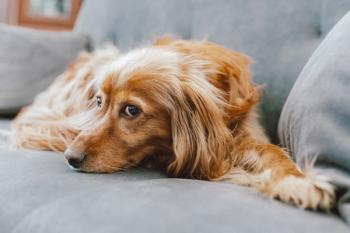
Down dogs: disk disease, the steroid controversy and beyond (Proceedings)
Acute paraplegia is a sudden onset of paralysis in the pelvic limbs, and is a common problem in small animal patients. Paraparesis is weakness in the pelvic limbs due to a neurologic cause, and can be quite variable in severity (ambulatory to non-ambulatory).
Definitions
Acute paraplegia is a sudden onset of paralysis in the pelvic limbs, and is a common problem in small animal patients. Paraparesis is weakness in the pelvic limbs due to a neurologic cause, and can be quite variable in severity (ambulatory to non-ambulatory).
Etiologies and differential diagnosis
Intervertebral disk disease (IVDD) is responsible for the majority of cases presenting to the small animal practitioner with acute paraplegia. However, it is important to bear in mind that other etiologies are possible, and an appropriate differential diagnosis list should be developed. Other disease mechanisms to consider are trauma, inflammatory disease, neoplasia, vascular accidents and acute neuromuscular disorders.
Trauma is usually obvious based on the history and physical examination findings, but this is not always the case. Potential trauma patients should be handled very carefully and preferably restrained until radiography can be used to assess the extent of their injuries. Inflammatory disease (meningiomyelitis) often presents with multifocal signs affecting the thoracic limbs and brain as well as the pelvic limbs, but focal thoracolumbar myelopathies are occasionally seen. Neoplasia is typically more chronic and insidious in onset, but can present acutely, sometimes in association with sudden hemorrhage. Vascular diseases, particularly fibrocartilagenous embolism (FCE), are the main differential for IVDD in many cases, as they have an acute onset and are often asymmetrical. However, in contrast to IVDD, these conditions are typically non-painful. Some neuromuscular conditions (e.g., acute polyradiculoneuritis, tick paralysis, botulism, coral snake envenomation) may have an acute presentation. These disorders usually progress to involve all four limbs and are characterized by flaccidity in association with reduced or absent segmental spinal reflexes.
Finally, a number of non-neurologic conditions may cause an animal to be presented for inability to ambulate. These include long bone fractures, severe osteoarthritis, bilateral cranial cruciate ligament rupture, and polyarthritis. These conditions are differentiated from spinal cord disease by thorough physical, neurologic and orthopedic examinations.
Neurologic examination
The hallmarks of spinal cord disease are ataxia, paresis/plegia and postural reaction deficits (hopping, proprioceptive placing). Patients with orthopedic or other non-neurologic conditions should not display these abnormalities. Animals with spinal cord lesions caudal to the T2 level can almost always pull themselves around with their front legs. If the animal is laterally recumbent or cannot use its thoracic limbs in this manner, a lesion in the C1-T2 region should be considered. Assessment of segmental spinal reflexes should allow the practitioner to put the lesion at one of four spinal cord levels: C1-5, C6-T2, T3-L3 or L4-S2. This is important when considering diagnostic testing and potential etiologies. As mentioned above, animals with acute neuromuscular conditions typically show reduced or absent reflexes in all four limbs along with flaccid paralysis.
Deep pain perception, assessed by squeezing on the bone of one of the digits of an affected limb with hemostats or between the handle of a boxed instrument, is a crucial part of the examination, as it impacts the prognosis and potential time to recovery of the patient. The appropriate response is cerebral recognition of the pain, characterized by crying out, turning to look at the limb or trying to bite the examiner. Withdrawal of the limb is a reflex only, and does not indicate pain perception.
Diagnostic plan
Acute paraplegia should be considered an emergency situation, as surgical intervention may be required as soon as possible to achieve the best result. Diagnostic testing revolves around imaging tests. Survey spinal radiographs are indicated to rule out traumatic processes (fracture or dislocation) or neoplastic conditions affecting the vertebrae. If the lesion is localized to the T3-L3 spinal segment, it is important to image the entire thoracic and lumbar spine to avoid missing potential lesions outside of the expected location for IVDD (i.e. T11-L4). Although calcified disks in situ are often seen on survey radiographs, and a narrowing of the intervertebral disk space and increased density within the intervertebral foramen are suggestive of IVDD, additional diagnostic imaging is typically required before definitive therapy.
Specialized diagnostic imaging of the spinal cord may involve myelography, computed tomography (CT), magnetic resonance imaging (MRI) or combinations of these modalities. Myelography has been the standard test for a number of years, but is gradually being supplanted in most specialty hospitals by CT and MRI. Myelography allows visualization of large portions of the spine and spinal cord, but is not without side effects. Although currently used contrast agents are less toxic to the central nervous system than those used in previous years, they still create an inflammatory response, which can result in worsening of clinical signs (such as loss of deep pain sensation) and seizures.
CT has the advantage of being noninvasive, but as images are acquired in the transverse (cross-sectional) plane, examination of other planes requires computerized reformatting of the images. As CT uses X-rays to generate the image obtained, chondrodystrophic dogs that have calcification of extruded disk material may be adequately imaged with CT alone. This may not be the case for disk protrusions in larger dogs or other disease processes, where interpretation may be less clear. CT can be used very effectively after myelography to define the area of spinal compression, and is particularly useful to determine lateralization of compressive lesions, which becomes important for the surgical approach, if required. Similar to CT, MRI is noninvasive, and in addition, can acquire images in multiple planes (e.g., sagittal, transverse, dorsal). It allows much better visualization of soft tissue structures and lesions than CT, and is the imaging modality of choice, if available. Inflammatory and vascular lesions are best visualized with MRI.
If myelography is used, cerebrospinal fluid (CSF) should be collected for analysis before the injection of contrast agent, as it will show an inflammatory response afterwards. The main concern is to rule-out meningomyelitis, (which usually results in elevated CSF cell counts and protein). Compressive lesions (IVDD, neoplasia) and vascular lesions often show elevated CSF protein without pleocytosis. A diagnosis of FCE is made in dogs with the appropriate signalment (typically large breeds or miniature Schnauzers) and neurologic signs (usually lateralized, non-painful) where compressive lesions and inflammatory disease are ruled out by appropriate diagnostic imaging and CSF analysis. Electrodiagnostic testing (e.g., electromyography [EMG], motor nerve conduction velocity) is useful in documenting and defining neuromuscular lesions.
Treatment plan
Animals with traumatic injuries may require systemic stabilization or resuscitation before addressing the spinal cord injury (SCI). Hypotension and hypoxemia have deleterious effects on the spinal cord and must be corrected rapidly. For animals with compressive lesions caused by IVDD or trauma, the most critical part of therapy is decompressive surgery as soon as possible. This typically involves performing a hemilaminectomy, although other procedures, such as dorsal laminectomy or pediculectomy can be used. Time is of the essence for these patients, and most neurologists and surgeons consider acute compressive paraplegia a surgical emergency. Fractures or luxations usually require some sort of stabilization through internal fixation, although external stabilization with a brace or casting material combined with restricted activity and time can be effective in some cases. Neoplastic lesions may also require emergent decompression, although definitive therapy requires tumor excision (if possible), and often radiation therapy or chemotherapy.
The use of glucocorticoids for patients with acute paraplegia has a long and controversial history. These drugs can reduce inflammation associated with extruded disk material and decrease vasogenic spinal cord edema. These effects can be accomplished with anti-inflammatory doses of these medications (e.g., 0.5 mg/kg prednisone). Patients with meningomyelitis often benefit from anti-inflammatory or immunosuppressive glucocorticoid treatment. The rationale behind high-dose glucocorticoid therapy for SCI is not to reduce inflammation, but rather to combat oxidative damage to the spinal cord.
Trauma to the spinal cord is traditionally separated into primary and secondary injury processes. The former refers to actual damage occurring at the time of injury, such as laceration or tearing of tissue. Secondary injury refers to a cascade of events arising from the initial injury, which, unlike the primary injury, is ongoing and progressive in nature. Contusion of the spinal cord (from fractures, luxations or explosive disk herniations) and interruption of the blood supply lead to hemorrhage and/or ischemia, disturbances in cellular function, energy failure, calcium accumulation within cells (axons), and the production of oxygen free radicals. These free radicals further damage cellular membranes by lipid peroxidation, exacerbating injury, contributing to spinal cord edema and perpetuating a vicious cycle. High doses of methylprednisolone sodium succinate (MPSS) or prednisolone sodium succinate (PSS) have been shown to have antioxidant effects, and are used to reduce the effects of oxygen free radicals in contributing to spinal cord injury.
The evidence for and against high dose glucocorticoid therapy for acute paraplegia
Although frequently recommended, dexamethasone has shown minimal, and often contradictory effects in experimental studies or in clinical trials addressing SCI. Initial studies evaluating MPSS in SCI were primarily conducted in rat or cat models of injury.7 Techniques used to produce the injury varied (including hemisection of the cord, compression with epidural balloon devices, weights and surgical clips) although contusion-type injuries, usually generated by dropping a weight from a specified height, were probably used most frequently. These studies showed neuroprotective effects of MPSS, although the outcome measures varied and often did not include actual recovery of spinal cord function. In addition, MPSS was typically given before, at or a few minutes after the time of injury.
These experimental animal studies were considered promising enough to evaluate the use of these glucocorticoids in human SCI patients. Recommendations for the use of high dose MPSS have generally been based on the results of clinical trials conducted by the National Acute Spinal Cord Injury Study (NASCIS). The second of these trials (NASCIS II), completed in 1990, concluded that acute SCI was best treated with an initial bolus of MPSS (30 mg/kg) followed by a constant rate infusion of 5.4 mg/kg/hour for 23 hours. However, more recent critical evaluation of this study has led to serious concerns regarding its conclusions.
NASCIS II randomized SCI patients seen within 12 hours of injury (without predetermined severity) to one of three groups: MPSS (dose above), naloxone (5.4 mg/kg then 4/mg/kg/hour for 23 hours) or placebo. Outcome measures were pinprick and touch sensation (29 locations) and motor strength (using a complex scale evaluating 14 muscle groups) assessed at 6 weeks, 6 months and 1 year, and were reported for the right side of the body only. For these groups, the only statistically significant change was an improvement in sensation at 6 months (but not at 6 weeks or 1 year). The authors then re-analyzed the data, looking at a subgroup of individuals treated with MPSS within 8 hours of injury, and determined that these patients had improved motor scores when compared with other treatment groups. It is important to note that a post-hoc analysis of this type interferes with the randomization process and in this case significantly reduced the number of patients analyzed. In addition, the clinical relevance of this statistical improvement (i.e., improvement in a numerical motor score without meaningful improvement related to function) has been questioned. Finally, the group receiving MPSS 8 hours or more after injury had a worse outcome than the placebo group in this same time frame, suggesting that MPSS may be detrimental in some cases.
A handful of other human clinical trials and retrospective reviews have failed to show a benefit of MPSS therapy for SCI, and in some cases, have suggested a deleterious effect. Very little objective data is available concerning the use of MPSS or other glucocorticoids in veterinary patients with SCI. One study comparing high dose MPSS with a 21-aminosteroid compound and placebo in experimentally injured dogs failed to show a beneficial effect of either treatment. A second experimental study evaluating glucocorticoid therapy (MPSS followed by prednisone) and electroacupuncture found a beneficial effect of either therapy alone or in combination compared to controls in terms of return of proprioceptive function. Many authors have advocated MPSS administration for dogs with IVDD, although this treatment remains to be evaluated in a clinical trial of naturally affected dogs (one is currently underway – see below). A recent study examined 51 nonambulatory dogs less than 15 kg body weight that were treated with hemilaminectomy for IVDD. The dogs did not receive MPSS, and 100% recovered the ability to walk after surgery. However, all of the dogs in this study had deep pain sensation at the time of presentation.
Use of this evidence for small animal patients
Making recommendations for clinical veterinary patients based on the experimental studies and human clinical trials described above is fraught with difficulties. Although some animals with exogenous traumatic lesions may reflect the conditions commonly seen in humans, the majority of animals presenting for acute paraplegia are dogs with IVDD or FCE. Although contusive spinal cord lesions often occur in IVDD, compressive or purely vascular lesions may not reflect the same disease processes described in the human literature (typically traumatic processes). In addition, extrapolation of results in rodents, cats or humans to dogs should be undertaken with caution, as species differences in anatomy, neurophysiology, cellular responses to injury and drug metabolism may alter treatment effects.
The deleterious effects of glucocorticoids in human patients have been well described, including increased risks of hyperglycemia, wound infection, pneumonia and sepsis. Some of the experimental cat studies show disturbingly high mortality rates in the MPSS treated groups. A recent study of dogs with surgically treated IVDD found that dogs receiving dexamethasone prior to referral were 3.4 times more likely to develop adverse effects (including vomiting, diarrhea and urinary tract infection) than dogs receiving other types of glucocorticoids or none of these drugs. Gastrointestinal hemorrhage is a very frequent side effect of dexamethasone and MPSS administration in dogs, although in the author's experience, serious gastrointestinal side effects or systemic disease is rare after MPSS administration in veterinary patients. However, in light of the experimental and clinical evidence (or lack thereof), the use of high-dose MPSS for veterinary patients with SCI cannot be supported at this time.
New therapies
A number of other therapeutic interventions have been investigated for SCI, including 21-aminosteroids (lazaroids), DMSO, additional antioxidant drugs, opioid receptor antagonists, thyrotropin-releasing hormone, NMDA receptor antagonists, calcium channel antagonists, osmotic diuretics, and gangliosides. Although many have shown promising results in experimental trials, their benefit has been unclear in clinical patients, and none have shown improvement over MPSS treatment. Recently, the use of polyethylene glycol (PEG) administration for acute SCI has been evaluated in dogs with IVDD presenting with acute paraplegia and absent deep pain perception. This compound is thought to be able to seal defects in injured cell membranes, which may facilitate the recovery of injured axons. In this pilot study, the authors demonstrated the safety of intravenous administration of this compound, and noted better than expected recovery in the dogs evaluated. Thus, PEG may be a promising new treatment for dogs with acute, severe SCI, but should be evaluated in larger scale clinical trials before any firm conclusions can be made. A prospective, randomized, multicenter clinical trial evaluating MPSS and PEG versus placebo in dogs with acute SCI is currently underway, with interim results to be analyzed shortly.
References
Hall ED. J Neurosurg 1992;76:13.
Brown SA, et al. J Am Vet Med Assoc 1992;200:1849.
Coughlan AR. J Small An Pract 1993;34:117.
Sorjonen DC, et al. Compend Contin Ed Pract Vet 1989;11:248.
Faden AI, et al. Neurology 1983;33:673.
Hoerlein BF, et al. J Am Anim Hosp Assoc 1983;19:216.
Campbell JB, et al. Surg Neurol 1973;1:102.
Campbell JB, et al. J Neurosurg 1974;40:726.
Means ED, et al. J Neurosurg 1981;55:200.
Hoerlein BF, et al. J Am Anim Hosp Assoc 1985;21:67.
Braughler JM, et al. J Neurosurg 1982;56:838.
Braughler JM, et al. J Neurosurg 1983;59:256.
Hall ED, et al. J Neurosurg 1982;57:247.
Braughler JM, et al. J Neurosurg 1987;67:102.
Anderson DK, et al. CNS Trauma 1985;2:257.
Holtz A, et al. Acta Neurol Scand 1990;82:68.
Bracken MB, et al. N Engl J Med 1990;322:1405.
Short DJ, et al. Spinal Cord 2000;38:273.
Hurlbert RJ. Spine 2001;26:S39.
Hugenholtz H, et al. Can J Neurol Sci 2002;29:227.
Fehlings MG. Spine 2001;26:S56.
Nesathurai S. J Trauma Injury Infect Crit Care 1998;45:1088.
Coleman WP, et al. J Spinal Disord 2000;13:185.
Pointillart V, et al. Spinal Cord 2000;38:71.
George ER, et al. Am Surg 1995;61:659.
Gerhart KA, et al. Paraplegia 1995;33:316.
Poynton AR, et al. Injury 1997;28:545.
Coates JR, et al. Vet Surg 1995;24:128.
Yang J, et al. J Vet Sci 2003;4:97.
Bush WW, et al. J vet Emerg Crit Care 2004;14:S7.
Levine JM, et al. J Am Vet Med Assoc 2007;232:411.
Culbert LA, et al. J Am Anim Hosp Assoc 1998;34:129.
Toombs JP, et al. J Am Vet Med Assoc 1980;177:68.
Sorjonen DC, et al. Am J Vet Res 1983;44:1233.
Rohrer CR, et al. Am J Vet Res 1999;60:977.
Bracken MB, et al. JAMA 1997;277:1597.
Meintjes E, et al. Compend Contin Ed Pract Vet 1996;18:625.
Laverty PH, et al. J Neurotrauma 2004;21:1767.
Newsletter
From exam room tips to practice management insights, get trusted veterinary news delivered straight to your inbox—subscribe to dvm360.






